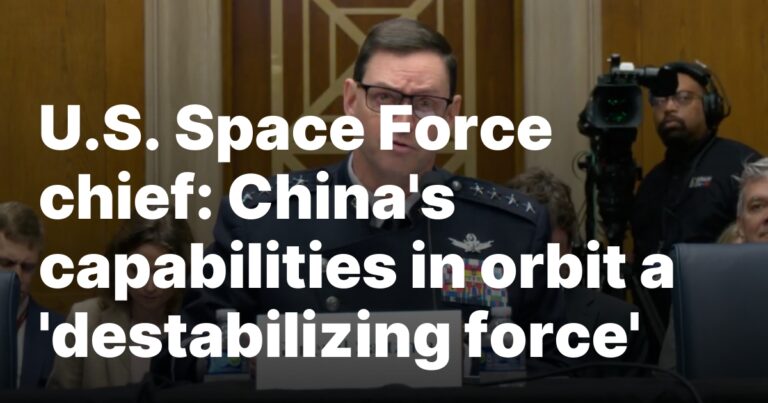WASHINGTON—The head of the U.S. Space Force warned a congressional commission April 3 that China’s rapidly advancing space program presents a significant challenge to American dominance in orbit, though he cautioned against viewing the competition as a simplistic “space race.”
Gen. Chance Saltzman, chief of space operations for the U.S. Space Force, told the U.S.-China Economic and Security Review Commission that Beijing’s space ambitions constitute a “powerful destabilizing force” in the increasingly contested domain.
The commission, established by Congress but composed of appointed commissioners rather than lawmakers, is tasked with monitoring and reporting on national security implications of U.S.-China economic relations. The commissioners heard testimony that China’s on-orbit capabilities now rank second only to the United States.
“We’re progressing every day in our readiness,” Saltzman said. “I’m still pretty satisfied with the U.S. Space Force.” He noted that direct comparisons can be misleading because China focuses primarily on the Western Pacific region while the U.S. maintains a global presence.
Of particular concern, said Saltzman, is China’s growing arsenal of counterspace weapons, including ground-based anti-satellite missiles, laser systems, and electronic warfare capabilities. He highlighted Chinese experimental satellites that have demonstrated the ability to manipulate other satellites — technology that could be repurposed from civilian “inspection and repair” missions to military applications.
When pressed by the commissioners on his prepared testimony that mentioned “overly restrictive space policy and outdated ways of thinking,” Saltzman clarified that space issues “haven’t risen to the level where we need to adjust our policies.”
“Space has been out of sight, out of mind,” he said.
The Space Force chief identified several areas where policy adjustments could be beneficial, including reducing classification levels to facilitate information sharing with private industry and streamlining approval processes for on-orbit testing and tactics validation.
“We have to go to very high levels of approval for testing, training. We do all training in simulation, we don’t do live training due to policies in place,” Saltzman explained.
Reduced budget is a problem
However, he emphasized that resource constraints, not policy limitations, represent the greater challenge. “The budget is what I have, that is a form of self-constraint. We have more unfunded than funded,” he said, referencing what he has previously described as a “shrinking” Space Force due to budget reductions over the past two years.
When commissioners asked which specific programs lack adequate funding, Saltzman indicated that while basic categories are covered, resources are spread thin across many programs. Many technologies remain in research and development phases, and he expressed a desire for additional funding to “go faster and develop more capacity.”
He pointed to Space Force training simulators as an example, describing them as “pretty low fidelity” compared to the sophisticated threats U.S. forces are likely to encounter.
The commission also heard testimony from other experts.
David Cavossa, president of the Commercial Space Federation, emphasized that while the U.S. maintains its position as the global leader in space, China is “aggressively pursuing its goal to become a world leader in space by 2050.”
Cavossa highlighted China’s advantages, including state-backed financing and fewer regulatory constraints. He pointed to Beijing’s progress with the Tiangong space station, lunar research initiatives, Mars exploration, and rapid deployment of low Earth orbit satellite constellations.
“The United States commercial space industry has the innovations and the talent to maintain American leadership in space and dominance in technology,” Cavossa told the commission. “We just need a willing partnership with the government to realize our full potential.”

